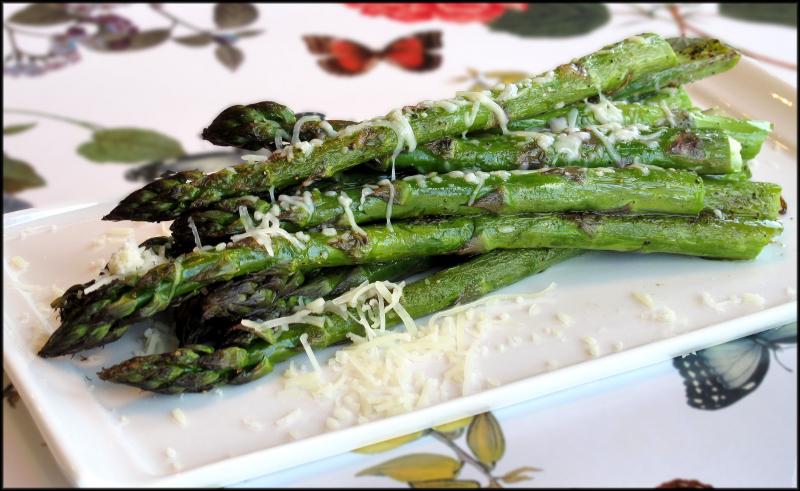Asparagus season is here in Sussex
One of my favorite signs of spring arrived last week at Lloyd’s Market in Lewes - local asparagus. The stalks were perfectly fresh, as chubby as my thumbs and still moist at the bottom cut. Since they were all about the same thickness, these were the perfect candidates for roasting; they would all be cooked through at the same time.
Asparagus is quite adaptable to a variety of cooking methods. In addition to oven roasting, the stalks can be steamed, poached, grilled, sautéed or stir-fried. Fresh, slender stalks can be sliced on the bias and tossed into a salad. Since asparagus has a relatively bland flavor on its own, sauces and seasonings can be as simple as salt or as rich as Hollandaise.
From now until mid-June is the best time to find locally grown asparagus. The supplies offered at supermarkets the rest of the year are likely sourced from Peru, and will not be as fresh and flavorful. The tips should be tight and bright green, and the surface of the spears smooth.
At the market, bundles of asparagus stalks are usually arranged standing upright in a shallow tray of water. This is an attempt to keep the cut edges looking moist, much the same way you keep cut flowers in a vase of water. However, if there are ridges in the stalks or dried flesh at the bottom, they’re past their prime.
While the asparagus in the photo are green, they also come in white and purple. Once they’re cooked, the purple variety turns dark green and they taste similar to the regular green. White asparagus is grown in the dark, under a blanket of mulch to prevent the development of chlorophyll.
Green and purple asparagus are best cooked al dente, as the transition from tender to mush can happen in an instant. White asparagus needs to be peeled and well-cooked. Choose thin spears for stir fries and other quick-cooking methods; choose the fatter spears for grilling or roasting.
Although the best method for trimming the stalks results in spears of different lengths, it also makes sure the woody ends are gone. Hold a spear with one hand at the tip and the other hand near the bottom. Bend the spear slightly to see where the natural breaking point is; it should snap at the point where the moisture loss has stopped.
I’ve included recipes for a few of the different ways to cook asparagus. If it’s an ingredient in a pasta dish, risotto or quiche, it should be blanched before it is added to the mixture. Steamed asparagus is a simple approach to showcase stalks topped with a lemon vinaigrette.
Asparagus salad is a refreshing garnish for grilled chicken breasts. Grilling asparagus can be a challenge to keep stalks from falling through the grates, so this foil-packet approach makes it easier. If you want that authentic smokiness, remove the stalks from the packet and place them directly on the grill for a minute or so.
Roasting asparagus remains my favorite technique. It’s fast, easy and adds a rich flavor to the stalks - delicious on their own or sprinkled with Parmesan cheese. Happy Spring!
Oven Roasted Asparagus
1 bunch asparagus
2 T olive oil
salt & pepper
shredded Parmesan cheese
Preheat oven to 400 F. Line a baking pan with aluminum foil; set aside. Rinse asparagus, dry thoroughly and trim off woody ends. Arrange spears on the baking sheet in a single layer. Drizzle with olive oil and sprinkle with salt and pepper. Shake the pan from side to side to thoroughly coat each piece with oil. Roast for 12 minutes for a slightly crisp texture. Serve garnished with shredded Parmesan cheese.
Grilled Asparagus
1 bunch asparagus, trimmed
1 T olive oil
1 t white Balsamic vinegar
1/2 t salt
1/4 t pepper
3 T grated Parmesan (optional)
Preheat gas grill on high. Cut a piece of heavy-duty aluminum foil twice as long as the asparagus spears. Place the spears in the center of the foil. Drizzle with oil and vinegar; sprinkle with salt and pepper. Fold the foil around the spears, sealing the center and ends with a double crimp. Place the packet on the grill, close the lid and cook for 5 minutes. Remove the packet from the heat and allow to cool for a couple of minutes. Open carefully, avoiding the steam, and place the spears on a serving platter; garnish with Parmesan cheese or lemon juice.
Steamed Asparagus
1 bunch asparagus, trimmed
Place a steamer insert in a wide, shallow pot. Add one inch of water and bring to a boil. Once the water has begun to boil, place a single layer of asparagus in the steamer. Cover and cook for 3 minutes. Remove to a serving tray and repeat with the remaining stalks. Dress with vinaigrette; serve warm.
Blanched Asparagus
1 bunch asparagus
1 t salt
Fill a large bowl with ice cubes and enough water to reach halfway to the rim; set aside. Trim the asparagus and cut into 1-inch pieces. Fill a pot with 3 inches of water; add the salt and bring to a boil. Once the water is at a rapid boil, add the asparagus. Cook for 1 minute. Drain and place the asparagus in the ice bath; remove after 1 minute and proceed with recipe.
Asparagus Salad
6 fat asparagus spears
2 T olive oil
1 T lemon juice
1/4 t lemon zest
1/4 t white pepper
1/8 t salt
Trim the asparagus spears and cut into thin, one-inch slices on the diagonal; set aside. In a small serving bowl, whisk together the remaining ingredients. Add asparagus and toss to combine. Use as a garnish for grilled chicken or as a small side dish.
















































